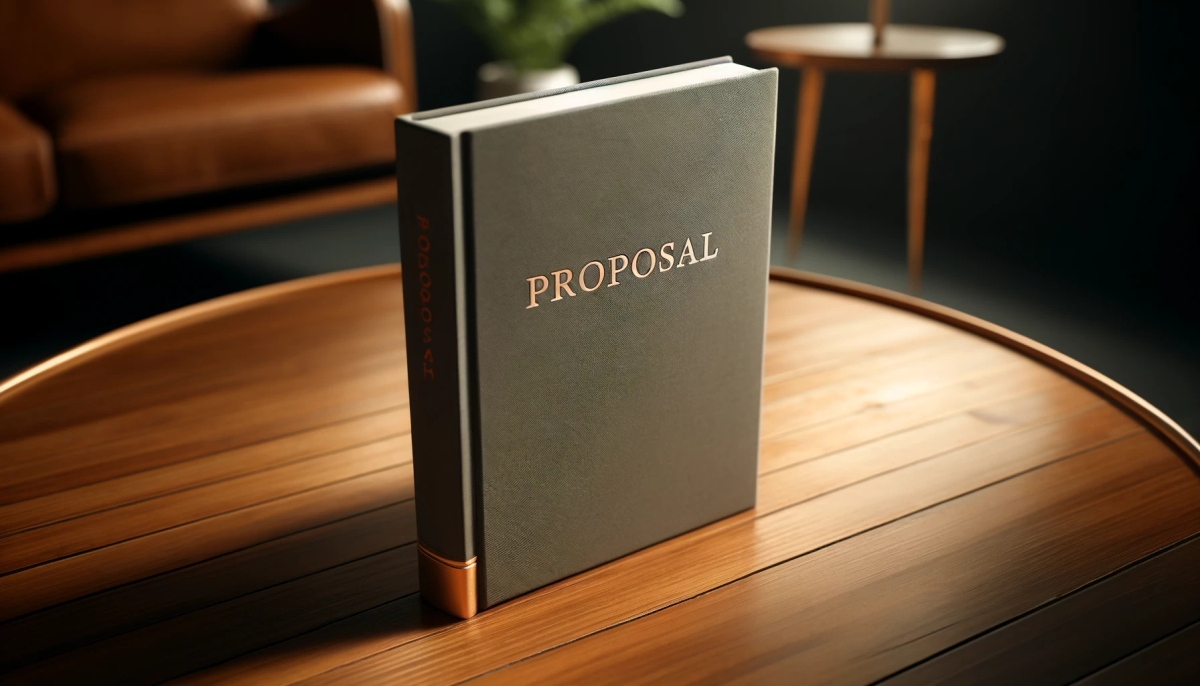
Your proposal cover page may seem trivial compared to the content itself, but it holds more sway than many give it credit for. After all, it's the visual embodiment of that crucial first handshake and (to pinch that old guidance counselor mantra) “you don’t get a second shot at a first impression.”
Through this post, we'll unpack the secrets to structuring a winning cover page. One that communicates your professionalism and attention to detail from the get-go, setting the stage perfectly for the winning proposal to follow.
Key takeaways
- A proposal cover page is crucial for making a strong first impression and should communicate essential details about the proposal.
- A strong cover page should be clear, concise, and reflect the brand's values, with a touch of creativity and personalization.
- The structure of a cover page should start with the basics, incorporate branding, add a creative touch, personalize where possible, and guide with a call-to-action.
- The cover page should be clean, uncluttered, high-quality, and reflect the client's style to create a sense of alignment.
- Proposal software can provide templates and examples to create a compelling entry point for proposals.
Why is your proposal cover page important?
Walking into a bookstore, what's the first thing that grabs your attention? The cover of a book, right? The visual impact of its design and composition. It prompts you to pick it up, flip it over, and read the back. Now, apply that same logic to your proposal. In the sea of documents your client wades through, your cover page is your book cover. It's your chance to stand out, to say, "Hey, I'm different. Take a closer look."
No matter how brilliant the content, a lackluster cover sheet might mean it never gets the attention it deserves. In contrast, a compelling cover signals to your client that what lies within is worth their time, establishing a connection before a word is read.
But it's not just about aesthetics. Your cover page is a prime real estate to communicate essential details: who you are, what you're proposing, and why your solution stands out.
So, as we discuss the elements of a strong cover page, remember that you're not just creating a cover; you're crafting an invitation, the irresistible impetus for your client to read on.
Read next: How to write a ghostwriting proposal
4 Essential features of a strong cover page
A strong cover page tells your prospective clients that you've got what it takes even before they dive into the specifics- it signifies your professionalism and attention to detail.
1. Clarity and concision
Your proposal title, company name, and date should be visible at a glance. This isn't the place for mystery; clarity reigns supreme. A succinct cover page says, "We respect your time, and we know what we're about." Remember, you'll go deeper into your messaging in your cover letter (and the rest of the proposal) so less really is more here.
2. Branding that speaks volumes
Your cover title page design is a prime opportunity to make your brand shine. It should be sleek, professional, and memorable. Whether through the strategic use of colors, your logo, or typography, every element should tie together to reflect your brand's values. Be careful not to go overboard on the ‘memorable’ though- it doesn’t take much of a misstep before you’re straying into garish (or trying too hard) territory…
3. A touch of creativity
While professionalism is key, adding a creative touch can set you apart from the sea of generic proposals. Maybe it's a unique layout, a surprising splash of color, or an imaginative use of visuals that relate to the client's industry or the project. This creative flair should say, "We're thinkers and innovators ready to bring fresh ideas to the table." A little creativity goes a long way here.
4. Personalization for the win
Personalizing your cover page to the client or the project shows you're not just recycling the same proposal for every pitch. It's like receiving a handwritten note in a world of emails; it makes the recipient sit up and take notice.
How to write and structure your proposal cover page
Writing your sales proposal cover page is about weaving together the elements we've discussed into a coherent and engaging introduction. Here's how to do it, step by step.
Step 1: Start with the basics
Before diving into the creative deep end, ensure the basics are in place. Your company name, the submission date, the title of the proposal, and your contact information should be front and center. These are your anchor points; everything else revolves around them. Think of this step as laying the foundation of a house. Without a strong foundation, it doesn't matter how beautiful the building is—it won't stand firm. Ensure these elements are clearly visible and positioned logically on the page.
Step 2: Incorporate your branding
Once the basics are down, it's time to dress up your cover page in your brand's colors, fonts, and style. Like choosing the right tie for your suit, it's about finding the balance that says professional yet distinctive. Consistency is key. Your proposal should feel like an extension of your brand identity, offering a seamless experience from cover to cover.
Step 3: Add your creative touch
With the foundation set and your branding in place, you can now afford to be playful! Add the creative element that makes your cover page stand out. However, this creativity should never come at the expense of readability or professionalism. It's like adding a pop of color to a professional outfit—it should enhance, not distract. Coming up with the perfect title or choosing a compelling image may be all you really need here.
Step 4: Personalize where possible
Personalization makes your proposal feel tailored and deliberate. Mention the client's name or include a nod to their brand in your design. This step shows the client that this proposal is crafted just for them. It shows effort, attention to detail, and, most importantly, that you value the relationship.
Step 5: Guide with a call-to-action
Lastly, consider including a subtle call-to-action. This could be as simple as "Looking forward to discussing this further" or a note about the proposal's validity period. It's your first invitation to engage, a gentle nudge to the client that there's more to come and you're eager for the next step. If you're responding to an RFP with a very strict process, this step may not be relevant to you. It's not worth being disqualified because you added page components that are not allowed.
Proposal title page and cover page tips
So, you've nailed the structure of your proposal cover page. Now, let's add some final touches to elevate and differentiate it. Here are a few tips that will help you create that killer cover page.
Tip 1: Keep it clean and uncluttered
A clean, uncluttered cover page isn't just aesthetically pleasing; it's also more effective. It's like walking into a well-organized room—everything feels just right, and you instantly know where to look. Use whitespace to your advantage, allowing each element at the start of your proposal document to breathe. This approach not only enhances readability but also communicates a sense of professionalism and attention to detail.
Tip 2: Quality matters
From the paper you use for a printed proposal to the resolution of images on a digital asset, quality should never be compromised. A high-quality cover page sends a message that you care about the presentation and, by extension, the project and the client. Ensure your images are high-resolution and your text is crisp and clear. These small details can leave a big impression.
Tip 3: Reflect your client's style
While your proposal should authentically represent your brand, incorporating elements of your client's brand style can create a powerful sense of alignment. This could mean using colors that reflect their brand palette or a style that resonates with their corporate identity. But remember, this should complement, not overshadow your branding. It's about finding the perfect balance that respects both identities.
5 Proposal cover page examples
Qwilr’s proposal software includes a rich library of templates, showcasing how design and content can harmonize to create a compelling entry point for your proposals.
Explore these examples further as the basis (or inspiration) for your next game-changing proposal….
SaaS proposal cover page
This SaaS proposal cover page uses a minimalist layout accented with tech-inspired imagery, immediately communicates a sense of modernity and innovation. It's not just a cover page; it's an invitation to embark on a journey of discovery and advancement.

Graphic design proposal cover page
For a graphic design proposal, the cover page is a canvas, a place to showcase creativity and flair. It can be tempting to take a big swing and end up with something cluttered or polarising. This example doesn’t try to beat the door down, instead leaning toward sleek, professional, and understated.

Consulting firm proposal cover page
Elegance and professionalism are the hallmarks of this consulting firm proposal cover page. With a clean, structured layout and a color scheme that speaks to reliability and trust, this cover page conveys a sense of expertise and authority. A subtle use of geometric patterns adds depth without detracting from the overall simplicity.

Nonprofit organization proposal cover page
This cover page for a nonprofit organization proposal combines heart and professionalism. Using imagery to tell the story. It evokes emotion and compassion, coupled with a clear, impactful message. The cover page immediately connects with the reader on a human level, with a design that is simple and direct.

Video production proposal cover page
This video production proposal cover page toes the line between professional and playful. Like the graphic design cover page, it is an opportunity to showcase your brand's creativity in a subtle yet emphatic fashion.

Final Thoughts
We’re hardwired to make quick judgments, and your cover page is where your prospective clients will form theirs. So don’t go in with a wet, limp handshake. Use Qwilr to ensure your first impression is a lasting one. It's easy to get started. You can sign up for a 14-day free trial to start designing your proposal cover page now. Or, book a demo for a bit more support and personalized guidance.
About the author

Marissa Taffer|Founder & President of M. Taffer Consulting
Marissa Taffer is the Founder & President of M. Taffer Consulting. She brings over 15 years of sales and marketing experience across various industries to a broad range of clients.
Frequently asked questions
Absolutely, they do! It's not just a formality; it sets the stage for everything that follows. A well-designed title page primes your clients, letting them know they're about to delve into something crafted with care and consideration.
Refreshing your proposal templates regularly—say, once a year or whenever there's a significant change in your branding or offerings—keeps your proposals fresh and aligned with your current brand identity and value proposition. It shows your clients you're evolving and paying attention to the details.
Incorporating a testimonial on your cover page can be a good power move. It's like starting a conversation with a strong endorsement from someone already in your corner. However, keep it succinct and relevant. A short, impactful quote from a satisfied client sets a positive tone and builds credibility right from the start.



